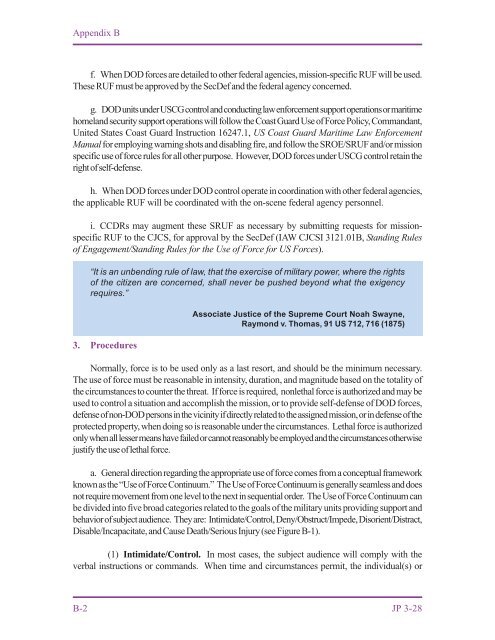JP 3-28, Civil Support - Federation of American Scientists
JP 3-28, Civil Support - Federation of American Scientists
JP 3-28, Civil Support - Federation of American Scientists
Create successful ePaper yourself
Turn your PDF publications into a flip-book with our unique Google optimized e-Paper software.
Appendix B<br />
f. When DOD forces are detailed to other federal agencies, mission-specific RUF will be used.<br />
These RUF must be approved by the SecDef and the federal agency concerned.<br />
g. DOD units under USCG control and conducting law enforcement support operations or maritime<br />
homeland security support operations will follow the Coast Guard Use <strong>of</strong> Force Policy, Commandant,<br />
United States Coast Guard Instruction 16247.1, US Coast Guard Maritime Law Enforcement<br />
Manual for employing warning shots and disabling fire, and follow the SROE/SRUF and/or mission<br />
specific use <strong>of</strong> force rules for all other purpose. However, DOD forces under USCG control retain the<br />
right <strong>of</strong> self-defense.<br />
h. When DOD forces under DOD control operate in coordination with other federal agencies,<br />
the applicable RUF will be coordinated with the on-scene federal agency personnel.<br />
i. CCDRs may augment these SRUF as necessary by submitting requests for missionspecific<br />
RUF to the CJCS, for approval by the SecDef (IAW CJCSI 3121.01B, Standing Rules<br />
<strong>of</strong> Engagement/Standing Rules for the Use <strong>of</strong> Force for US Forces).<br />
B-2<br />
“It is an unbending rule <strong>of</strong> law, that the exercise <strong>of</strong> military power, where the rights<br />
<strong>of</strong> the citizen are concerned, shall never be pushed beyond what the exigency<br />
requires.”<br />
3. Procedures<br />
Associate Justice <strong>of</strong> the Supreme Court Noah Swayne,<br />
Raymond v. Thomas, 91 US 712, 716 (1875)<br />
Normally, force is to be used only as a last resort, and should be the minimum necessary.<br />
The use <strong>of</strong> force must be reasonable in intensity, duration, and magnitude based on the totality <strong>of</strong><br />
the circumstances to counter the threat. If force is required, nonlethal force is authorized and may be<br />
used to control a situation and accomplish the mission, or to provide self-defense <strong>of</strong> DOD forces,<br />
defense <strong>of</strong> non-DOD persons in the vicinity if directly related to the assigned mission, or in defense <strong>of</strong> the<br />
protected property, when doing so is reasonable under the circumstances. Lethal force is authorized<br />
only when all lesser means have failed or cannot reasonably be employed and the circumstances otherwise<br />
justify the use <strong>of</strong> lethal force.<br />
a. General direction regarding the appropriate use <strong>of</strong> force comes from a conceptual framework<br />
known as the “Use <strong>of</strong> Force Continuum.” The Use <strong>of</strong> Force Continuum is generally seamless and does<br />
not require movement from one level to the next in sequential order. The Use <strong>of</strong> Force Continuum can<br />
be divided into five broad categories related to the goals <strong>of</strong> the military units providing support and<br />
behavior <strong>of</strong> subject audience. They are: Intimidate/Control, Deny/Obstruct/Impede, Disorient/Distract,<br />
Disable/Incapacitate, and Cause Death/Serious Injury (see Figure B-1).<br />
(1) Intimidate/Control. In most cases, the subject audience will comply with the<br />
verbal instructions or commands. When time and circumstances permit, the individual(s) or<br />
<strong>JP</strong> 3-<strong>28</strong>

















